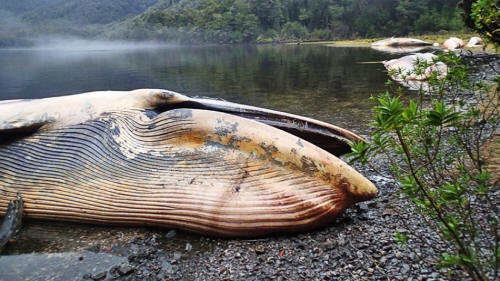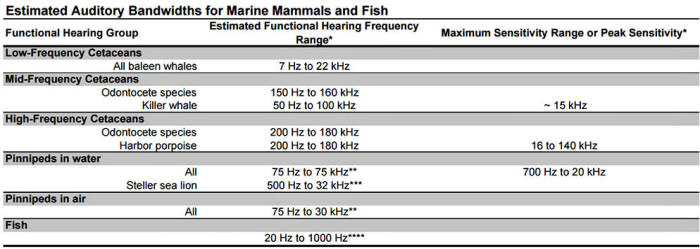|

by Christopher Fontenot
July 17, 2016
from
AMicrowavedPlanet Website

Our oceans are fast becoming a killing field for many marine mammals
and other sea dwellers.
Beachings are occurring with more
frequency than ever. Mass fish kills are a common occurrence.
Scientists are calling this the "Sixth Great Extinction Event". Yet,
few are correlating these changes to increases in energy and
perturbations in the electromagnetic spectrum.
Modern technology is having a profound
impact on marine life, the likes of which hasn't been witnessed by
modern man.
In order to understand why our oceans
are highly susceptible to electromagnetic radiation (EMR),
it's important to know the characteristics of EMR in water.
"Electromagnetic propagation through
water is very different from propagation through air because of
water's high permittivity and electrical conductivity.
Plane wave attenuation is high
compared to air, and increases rapidly with frequency.
With a relative permittivity of 80,
water has among the highest permittivity of any material and
this has a significant impact on the angle of refraction at the
air/water interface."
"Conductivity of seawater is typically around 4S/m, while
nominally 'fresh' water conductivity is quite variable but
typically in the mS/m range. Attenuation of em signals is much
lower in fresh water than in seawater, but fresh water has a
similar permittivity.
Relative permeability is
approximately 1, so there is little direct effect on the
magnetic field component. Loss is largely due to the effect of
conduction on the electric field component.
Propagating waves continually cycle
energy between the electric and magnetic fields; hence
conduction leads to strong attenuation of electromagnetic
propagating waves."
Source
Marine mammals are experiencing an
onslaught of attack from many sources. The military admittedly kills
millions of cetaceans by sonar, seismic, and electromagnetic
technology.
The estimated audible range for all
cetaceans is between 7 Hz and 180 kHz.

Source
"Unfortunately for many whales,
dolphins and other marine life, the use of underwater sonar
(short for sound navigation and ranging) can lead to injury and
even death.
Sonar systems - first developed by
the U.S. Navy to detect enemy submarines - generate slow-rolling
sound waves topping out at around 235 decibels; the world's
loudest rock bands top out at only 130.
These sound waves can travel for
hundreds of miles under water, and can retain an intensity of
140 decibels as far as 300 miles from their source."
"These rolling walls of noise are no doubt too much for some
marine wildlife.
While little is known about any
direct physiological effects of sonar waves on marine species,
evidence shows that whales will swim hundreds of miles, rapidly
change their depth (sometime leading to bleeding from the eyes
and ears), and even beach themselves to get away from the sounds
of sonar."
Source
Whales and other marine species use the
Earth's Geomagnetic Stress Lines (GSLs) to navigate/migrate.
These GSLs correlate with the Earth's
magnetic field and are a natural occurring phenomena used by many
species for this purpose. During
geomagnetic storms, the GSLs may
change drastically.
These rapid changes are the primary
cause of stranding and poor navigation.
"The beaching and stranding of
whales and dolphins around the world has been mystifying
scientists for centuries. Although many theories have been
proposed, few are substantiated by unequivocal statistical
evidence.
Advances in the field of animal
magneto-reception have established that many organisms, including
cetaceans, have an internal 'compass,' which they use for
orientation when traveling long distances."
"Astrobiology involves not only the origin and distribution of
life in the universe, but also the scientific study of how
extraterrestrial conditions affect evolution of life on planet
Earth.
The focus of this study is how
cetacean life is influenced by disturbances in its environment
that originate from an astrological phenomenon - in the present
study that involves solar flares and cetacean beachings.
Solar storms are caused by major
coronal eruptions on the Sun.
Upon reaching Earth, they cause
disturbances in Earth's normally stable magnetosphere.
Unable to follow an accurate
magnetic bearing under such circumstances, cetaceans lose their
compass reading while travelling and, depending on their
juxtaposition and nearness to land, eventually beach themselves.
-
This hypothesis was
supported by six separate, independent surveys of
beachings:
(A) in the Mediterranean
Sea
(B) the northern Gulf of
Mexico
(C) the east
(D) west coasts of the
USA and two surveys
(E and F) from around
the world
When the six surveys were
pooled (1614 strandings), a highly significant
correlation (R2 = 0.981) of when strandings occurred
with when major geomagnetic disturbances in Earth's
magnetosphere occurred was consistent with this
hypothesis.
-
Whale and dolphin strandings
in the northern Gulf of Mexico and the east coast of the
USA were correlated (R2 = 0.919, R2 = 0.924) with the
number of days before and after a geomagnetic storm.
-
Yearly strandings were
correlated with annual geomagnetic storm days.
-
Annual beachings of
cetaceans from 1998 to 2012 were linearly correlated (R2
= 0.751) with frequency of annual sunspot numbers.
Thus, consistently strong
statistical correlation evidence indicates that an
astronomical phenomenon - solar flares - can cause
cetaceans to change their behavior and become
disoriented, which eventually causes them to swim onto a
shore and beach themselves."
Cetacean beachings correlate with
geomagnetic disturbances in Earth’s magnetosphere: an example of
howastronomical changes impact the future of life
These correlations between geomagnetic
storms and beachings fail to mention man-made perturbations of the
Earth's Ionospheric layers. The
geomagnetic field of Earth can be
perturbed via ionospheric heaters.
These heaters modulate an
Alfven wave
resonance in the Earth's Ionosphere, precisely as witnessed during
increased solar activity.
"Ionospheric heaters located in
Polar Regions (EISCAT,
HAARP, HIPAS) have been used extensively
to generate electromagnetic waves in the ULF/VLF/ELF frequency
range and this concept has been referred as the Polar
Electrojet
(PEJ) antenna.
A major problem with the PEJ is its
reliance in the presence and strength of the electrojet current.
This restricts not only the location of the heater but makes
their generation highly unpredictable.
A new concept of using HF heating to
generate a virtual antenna in the ionospheric Hall region at
ULF/ELF frequencies without relying in the existence of
electrojets, was advanced recently by Papadopoulos et al. (2010).
The current drive and the creation of a virtual ELF antenna are
accomplished in two steps.
First, F region heating generates a
diamagnetic current with a field aligned magnetic moment.
Second, the electric field of the
magnetosonic wave radiated by the F region magnetic moment
drives a Hall current when it reaches the bottom of the
ionosphere."
Source
In light of the roll out of 5G cellular
technology and proposed Wi-Fi on board satellites, mankind will face
serious consequences for our ignorance in utilizing unnatural
vibrations.
Nature took millions of years to
establish what mankind has thrown into chaos in less than 100.
While we contemplate our need to advance technology and control of
our EM spectrum, perhaps we should step back and examine the
consequences of our actions.
Our planet is suffering an 'Extinction
Level Event'.
|



